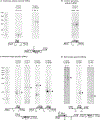Small non-coding RNAs in Caulobacter crescentus
- PMID: 18373523
- PMCID: PMC7540941
- DOI: 10.1111/j.1365-2958.2008.06172.x
Small non-coding RNAs in Caulobacter crescentus
Abstract
Small non-coding RNAs (sRNAs) are active in many bacterial cell functions, including regulation of the cell's response to environmental challenges. We describe the identification of 27 novel Caulobacter crescentus sRNAs by analysis of RNA expression levels assayed using a tiled Caulobacter microarray and a protocol optimized for detection of sRNAs. The principal analysis method involved identification of sets of adjacent probes with unusually high correlation between the individual intergenic probes within the set, suggesting presence of a sRNA. Among the validated sRNAs, two are candidate transposase gene antisense RNAs. The expression of 10 of the sRNAs is regulated by either entry into stationary phase, carbon starvation, or rich versus minimal media. The expression of four of the novel sRNAs changes as the cell cycle progresses. One of these shares a promoter motif with several genes expressed at the swarmer-to-stalked cell transition; while another appears to be controlled by the CtrA global transcriptional regulator. The probe correlation analysis approach reported here is of general use for large-scale sRNA identification for any sequenced microbial genome.
Figures





References
-
- Alvarez-Martinez CE, Lourenco RF, Baldini RL, Laub MT, and Gomes SL (2007) The ECF sigma factor sigma(T) is involved in osmotic and oxidative stress responses in Caulobacter crescentus. Mol Microbiol 66: 1240–1255. - PubMed
-
- Antal M, Bordeau V, Douchin V, and Felden B. (2005) A small bacterial RNA regulates a putative ABC transporter. J Biol Chem 280: 7901–7908. - PubMed
-
- Argaman L, Hershberg R, Vogel J, Bejerano G, Wagner EG, Margalit H, and Altuvia S. (2001) Novel small RNA-encoding genes in the intergenic regions of Escherichia coli. Curr Biol 11: 941–950. - PubMed
-
- Arini A, Keller MP, and Arber W. (1997) An antisense RNA in IS30 regulates the translational expression of the transposase. Biol Chem 378: 1421–1431. - PubMed
-
- Babitzke P, and Romeo T. (2007) CsrB sRNA family: sequestration of RNA-binding regulatory proteins. Curr Opin Microbiol 10: 156–163. - PubMed
Publication types
MeSH terms
Substances
Grants and funding
LinkOut - more resources
Full Text Sources
Other Literature Sources

